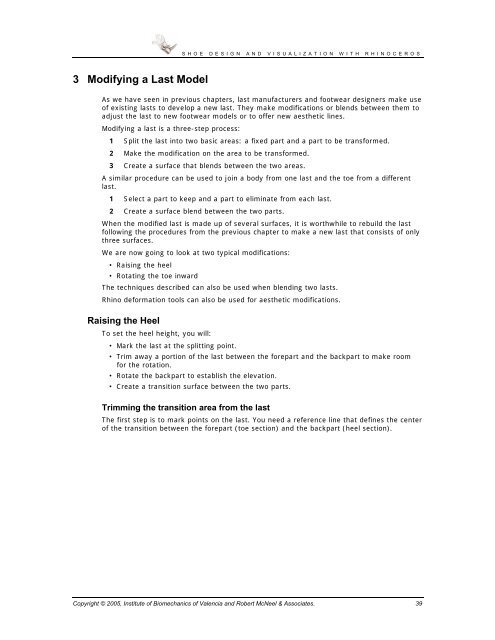Shoe Design and Visualization
Shoe Design and Visualization
Shoe Design and Visualization
You also want an ePaper? Increase the reach of your titles
YUMPU automatically turns print PDFs into web optimized ePapers that Google loves.
3 Modifying a Last Model<br />
SHOE DESIGN AND VISUALIZATION WITH RHINOCEROS<br />
As we have seen in previous chapters, last manufacturers <strong>and</strong> footwear designers make use<br />
of existing lasts to develop a new last. They make modifications or blends between them to<br />
adjust the last to new footwear models or to offer new aesthetic lines.<br />
Modifying a last is a three-step process:<br />
1 Split the last into two basic areas: a fixed part <strong>and</strong> a part to be transformed.<br />
2 Make the modification on the area to be transformed.<br />
3 Create a surface that blends between the two areas.<br />
A similar procedure can be used to join a body from one last <strong>and</strong> the toe from a different<br />
last.<br />
1 Select a part to keep <strong>and</strong> a part to eliminate from each last.<br />
2 Create a surface blend between the two parts.<br />
When the modified last is made up of several surfaces, it is worthwhile to rebuild the last<br />
following the procedures from the previous chapter to make a new last that consists of only<br />
three surfaces.<br />
We are now going to look at two typical modifications:<br />
• Raising the heel<br />
• Rotating the toe inward<br />
The techniques described can also be used when blending two lasts.<br />
Rhino deformation tools can also be used for aesthetic modifications.<br />
Raising the Heel<br />
To set the heel height, you will:<br />
• Mark the last at the splitting point.<br />
• Trim away a portion of the last between the forepart <strong>and</strong> the backpart to make room<br />
for the rotation.<br />
• Rotate the backpart to establish the elevation.<br />
• Create a transition surface between the two parts.<br />
Trimming the transition area from the last<br />
The first step is to mark points on the last. You need a reference line that defines the center<br />
of the transition between the forepart (toe section) <strong>and</strong> the backpart (heel section).<br />
Copyright © 2005, Institute of Biomechanics of Valencia <strong>and</strong> Robert McNeel & Associates. 39








